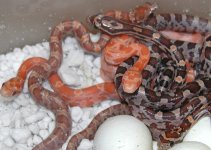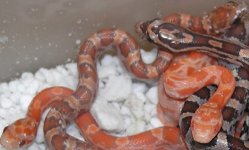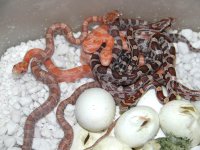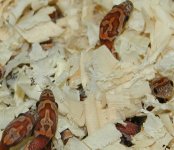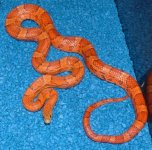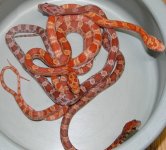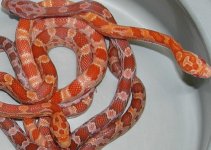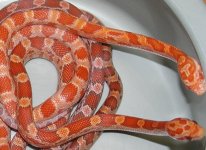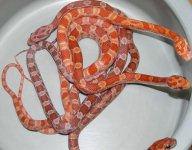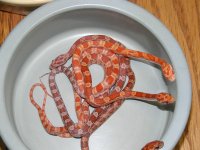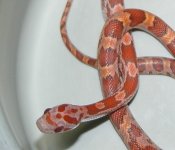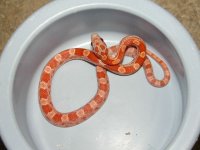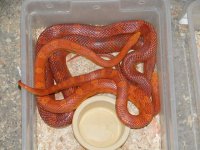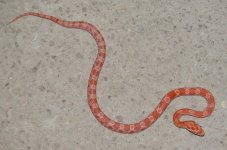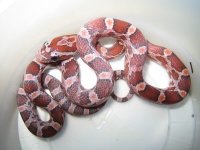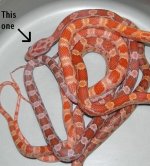ecreipeoj
Striped Topaz SK SG Free
I have been waiting for this clutch to hatch for a long time. The parents are from my test breeding between Lava X Sunkissed in 2003. I used a Lava Corn that later proved to be het for Snow in that test breeding, so the 2.5 Hets for Sunkissed Lava that I was breeding this year, where all poss het for Snow. I knew these poss het genes may complicate the identification of some of the hatchlings if they showed up, but it could also spice things up a bit.
The head patterns and other pattern traits of Sunkissed have been a topic of discussion lately, that it would be very nice to get into in more depth. This clutch will be a very good sample to look at and I have one more clutch due to hatch even later than this one, so there will be more numbers. Rich Z has also hatched F2’s from Sunkissed Projects so there should be quite a few hatchlings from these Sunkissed F2 projects to compare the head patterns on.
I do not have a great deal of experience with the Sunkissed, but I did hatch out my first clutch of Sunkissed this year and several projects from the Sunkissed like, Hets for Sunkissed Anery Stripes. From what I gather so far, it seems as if the head pattern on Sunkissed is linked to the Sunkissed gene and it does not show up in Hets for Sunkissed. This is consistent with what I have seen this year, although the numbers are limited.
So what morphs does this clutch contain? Serp and I were discussing what a Sun Lava or Lava Sun would look like and he said, that I would just be creating another one of those “Amel” looking things or something to that effect. My very first impression of the most extreme “Amel” looking snake in this clutch was that it was a Sun Lava, but is it? My first impression of the next most extreme “Hypo” looking hatchling was that it was a recovered Lava, but is it? There were several eggs that had not pipped, so I cut them open as I usually do. One had a small slit in it and I suspected that it was dead in the eggs, which it was. It appeared to look very similar to the “Amel” looking hatchling in the photo. There was one more that was dead in the egg and it appeared to look like the “Hypo” looking hatchling. The rest of the eggs appear to be still alive and one looks to be a “Ghost”, but perhaps not an Ice and one appears to be a Snow. Will we get to see a Sun “Ghost”/Anery or Sun Snow?
The head patterns and other pattern traits of Sunkissed have been a topic of discussion lately, that it would be very nice to get into in more depth. This clutch will be a very good sample to look at and I have one more clutch due to hatch even later than this one, so there will be more numbers. Rich Z has also hatched F2’s from Sunkissed Projects so there should be quite a few hatchlings from these Sunkissed F2 projects to compare the head patterns on.
I do not have a great deal of experience with the Sunkissed, but I did hatch out my first clutch of Sunkissed this year and several projects from the Sunkissed like, Hets for Sunkissed Anery Stripes. From what I gather so far, it seems as if the head pattern on Sunkissed is linked to the Sunkissed gene and it does not show up in Hets for Sunkissed. This is consistent with what I have seen this year, although the numbers are limited.
So what morphs does this clutch contain? Serp and I were discussing what a Sun Lava or Lava Sun would look like and he said, that I would just be creating another one of those “Amel” looking things or something to that effect. My very first impression of the most extreme “Amel” looking snake in this clutch was that it was a Sun Lava, but is it? My first impression of the next most extreme “Hypo” looking hatchling was that it was a recovered Lava, but is it? There were several eggs that had not pipped, so I cut them open as I usually do. One had a small slit in it and I suspected that it was dead in the eggs, which it was. It appeared to look very similar to the “Amel” looking hatchling in the photo. There was one more that was dead in the egg and it appeared to look like the “Hypo” looking hatchling. The rest of the eggs appear to be still alive and one looks to be a “Ghost”, but perhaps not an Ice and one appears to be a Snow. Will we get to see a Sun “Ghost”/Anery or Sun Snow?


